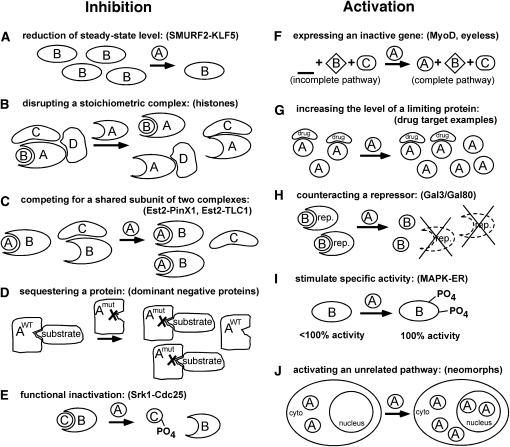Figure 3 .
Mechanisms responsible for overexpression phenotypes. Overexpression mechanisms can be placed into two broad categories that can inhibit (left column) or activate (right column) proteins, with specific mechanisms depicted below. For each variation, a representative example that is discussed more fully in the text is provided in parentheses. (A) Overexpression can simply reduce the steady-state levels of other proteins, by affecting their transcription, translation, or their rate of degradation. (B) Overexpression of subunit A that make multiple contacts within a multi-protein complex can result in partial A-B, A-D, or A-C subassemblies, thereby reducing the amount of the intact functional A-B-C-D complex. (C) If protein B participates in two separate A-B and A-C complexes, overexpression of nonshared subunit A could effectively compete for limiting amounts of protein B, reducing the amount of functional B-C complexes. (D) Overexpression of a mutant enzyme A that can still bind to its substrate competes that substrate from wild-type enzyme A by a classical dominant negative or antimorphic mechanism. (E) Overexpression can functionally inactivate proteins independent of competition-based mechanisms. Depicted here, post-translational modification of one subunit disrupts a protein–protein interaction. (F) Expressing a normally silent gene under a condition where the rest of a pathway is intact can activate its pathway. (G) Overexpressing a gene under a condition where it is expressed, but limiting, could increase total activity and stimulate output. (H) Counteracting a repressor by any number of mechanisms, including degradation of the repressor, inactivating it by post-translational modification or by direct competition could activate a pathway. In this example, overexpression of gene A results in degradation of a repressor (rep.), releasing active protein B. (I) Overexpression can increase the specific activity of other proteins. The most common mechanism is likely via post-translational modifications. (J) Overexpression can activate new pathways via neomorphic effects. Here, overexpression of the normally cytoplasmic protein A results in accumulation of a subpopulation in the nucleus, which causes a novel phenotype. See text for details.

